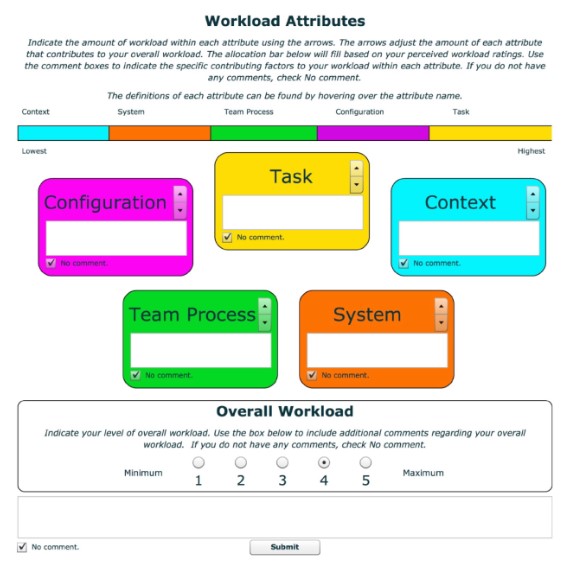Human Robot Interaction Workload Measurment (HRI-WM)
This is the most up to date version of this scale.
Construct Summary
The authors aimed to develop a measure that can
“evaluate the workload that is attributed to the overall human-robot system configuration.” (p. 305)
Mental workload is defined as:
“an inferred construct that mediates between task difficulty, operator skill, and observed performance” (p. 304)
They report 5 dimensions and define them as follows:
Task: the individual elements that are involved in the mission at hand. System: The system is comprised of the robot, operator control unit, interface, and, but not limited to, the payload (camera) Team Process: Processes involved with working with team members. A team can be defined as 2 or more entities (human and/or robot) working together. Processes can include communication, coordination, backup, etc. Team configuration: Human-to-robot ratio during the mission. Relative spatial location of each team member (human and/or robot) during the mission. Context: The environment, mission scenario, and other external factors that may contribute to workload.
Rating = 31%
| Check? | Guideline Item |
|---|---|
| ✓ | Is the construct defined? |
| ✖ | Does the final version of the items capture the construct as it has been defined by the authors? |
| ✓ | Is the item generation process discussed (e.g., literature review, Delphi method, crowd-sourcing)? |
| ✖ | Person to items 10:1 for the initial set of items? |
| ✖ | Did they perform an EFA, PCA, Rasch, or similar test to determine the item to factor relationship? |
| ✖ | Did they describe how they determined number of factors? |
| ✓ | Did they report the full initial set of items? |
| ✖ | Did they provide loadings (EFA) or item fits (Rasch) of all items? |
| NA | Is there a description of the item removal process (e.g., using infit/outfit, factor loading minimum value, or cross-loading values)? |
| ✓ | Did they list the final items included in the scale? |
| ✖ | Did they include a factor structure test (e.g., second EFA, CFA, DIF, test for unidimensionality when using Rasch, or similar)? |
| ✖ | Was a measure of reliability (e.g., Cronbach’s alpha, McDonalds Omega_h or Omega_t, Tarkkonen’s Rho) reported? |
| ✖ | Was a test of validity (e.g., predictive, concurrent, convergent, discriminant) reported? |
Comments Link for measure reported in paper does not work. No items were removed.
Reviewed by Experts ✓
Downloads
PAPER
Yagoda, R. E. (2010, September). Development of the human robot interaction workload measurement tool (HRI-WM). In Proceedings of the human factors and Ergonomics society annual meeting (Vol. 54, No. 4, pp. 304-308). Sage CA: Los Angeles, CA: Sage Publications.
PDF of instructions for administration and score not readily available. Check the paper for more details or email hriscaledatabase@gmail.com to submit this information if you are the author of this scale.
Final Scale Items (5 total):
Task
System
Team Process
Team Configuration
Context
Figure 3 from the paper (below) depicts a visualization of the task.
